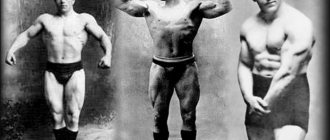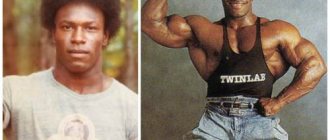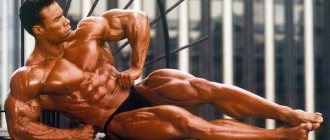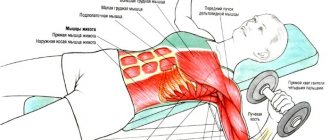There are a lot of bench press programs, and if you are working out without a coach who could write you a program or suggest the one that he considers the most effective, then it is important to choose the right one for yourself. They are usually written by coaches and athletes who have achieved significant results in this sport, so there are no programs that would be completely useless, although some may claim this.
Each person has his own body and what was completely unsuitable for one may be exactly what he was looking for for another. It’s the same with programs, you need to find the most suitable one for yourself, and even while practicing it, you must listen to your body - this is very important.
What is your personal best in the bench press?
- 100-119 23%, 6155 votes
6155 votes 23%6155 votes - 23% of all votes
- 120-139 19%, 4898 votes
4898 votes 19%
4898 votes - 19% of all votes
- 80-99 18%, 4785 votes
4785 votes 18%
4785 votes - 18% of all votes
- Up to 80 16%, 4205 votes
4205 votes 16%
4205 votes - 16% of all votes
- 140-159 12%, 3219 votes
3219 votes 12%
3219 votes - 12% of all votes
- 160-189 8%, 2171 votes
2171 votes 8%
2171 votes - 8% of all votes
- More than 190*3%, 866 votes
866 votes 3%
866 votes - 3% of all votes
Total votes: 26299
22.01.2018
* - added by visitor
When you feel that everything is going very hard, take an extra day of rest or reduce the number of approaches (repetitions), but you also shouldn’t feel too sorry for yourself. Remember that great results come from great effort.
The bench press varies
There are two main variations of the classic flat bench press:
- bodybuilding;
- powerlifting.
The latter is aimed at maximum results in one repetition, no matter how you achieved it. For example, techniques are used to reduce the range of motion, such as the “bridge”:
Also, in addition to the pectoral muscles, absolutely all possible assistant muscles are used to the maximum, starting with the legs, continuing with the back and ending with the triceps and deltoids. Compared to the bodybuilding version, the movement is similar, but at the core it is completely different.
Of course, with increasing strength, the volume of the pectoral muscles also increases, but developing them with the help of powerlifting is like hammering pushpins with a sledgehammer. Traumatic and meaningless. Perhaps, for variety, sometimes you can try power penetrations, but no more.
In this material, I will talk specifically about the bodybuilding version of the bench press, increasing strength indicators and effective chest training in general, which will require a number of other exercises.
However, if you want to work towards powerlifting, start with Yuri Belkin's :
And the nuances of the power bench press from him:
Features of the technology
In fitness, this option is most often accepted:
- the bench is installed at an angle of 30 to 45%;
- the dumbbells are given to the belayer, the arms are immediately brought to the starting position, the elbows are already bent, the shoulders are parallel to the plane of the floor (conditionally, in fact, they are located at a slight angle);
- then extension in the elbow joints and a press in one plane are performed, usually with exhalation;
- with inhalation - return to starting position
In bodybuilding, sometimes the bench press is performed at full amplitude - the elbows are lowered down and behind the bench, the pecs are stretched to the maximum. The peculiarity of this press is the low weight of the burden; the exercise is often used as the third or fourth after the classic bench press with dumbbells or movement with a barbell.
Often you have to take the starting position yourself; bringing the dumbbells to the starting position is done as follows:
first, they are placed next to the bench, sit down, with a straight back, lift the dumbbells to the level of the front surface of the thigh, then lie down at the same time, and bring the dumbbells, bringing them with their hips, to their original position
The downside of the technique is the need to lie down with your back already collected. Throwing dumbbells in this way is contraindicated if there are any injuries to the lumbar spine, and it is not possible to stabilize the dumbbells immediately due to a shoulder injury.
It is usually advised to use maximum weights in this exercise. This is true if the work is carried out with an insurer. It makes sense for two people to insure large weights. Pushes under the elbows are not allowed, due to the possible reflex unclenching of the fingers.
Sometimes a technique is used in which dumbbells are brought together in front of the chest, squeezing the muscles at the top point. It requires skill in stabilizing the scale and should not be used by beginners.
Extension in the elbow joints “until a click” is not allowed; this creates a shock load and can cause injury and inflammation.
The incline dumbbell press works the upper and inner edge of the pectoral muscle. The incline dumbbell press shapes, thickens, lifts and increases the volume of the upper chest.
Execution technique
- Place the back of the bench at 35-40° relative to the horizontal. Lie down on it, your legs should be wider than your shoulders and firmly resting on the floor. Shoulders, head and hips are pressed against the bench.
- Take the dumbbells with an overhand grip and lift them to the shoulder line (closer to the deltoids). Throughout the entire exercise, your palms should be directed where your eyes are looking - clearly up. This position is the starting point.
- Take a deep breath, stopping your breathing, press the dumbbells up so that they are directly above your shoulders. The elbows move exactly in the plane of the shoulders and always look to the sides.
- Having mastered the most difficult part of the climb, exhale.
- From above, the arms are completely straight, and the dumbbells are strictly above the shoulders. Pause for a couple of moments and tighten your chest muscles even more. Then, take a deep breath and, stopping your breathing, lower the dumbbells to the deltoids.
- When the dumbbells reach shoulder level, without stopping, immediately change the direction of movement and press the dumbbells up again.
- To improve the work of the upper part of the chest muscles, lift the dumbbells not stupidly up, but let’s say so that the dumbbells almost come together on top and are located opposite the middle of the upper edge of the chest.
- All stages of the exercise (pressing and lowering dumbbells) are performed slowly, without acceleration.
- To dilute it, I recommend performing a dumbbell press with one hand. At the same time, try to squeeze the dumbbell as high as possible.
- Stopping breathing during movement does not give rest to the stabilizer muscles, which increases the body's endurance and gives additional strength.
- Throughout the entire approach, the elbows move exactly in a vertical plane, which passes at shoulder level, and the elbows are constantly directed strictly to the sides. By bringing your elbows closer to the sides of your body, you run the risk of injuring your shoulder joint.
- From above, the arms should be completely straight, and the dumbbells should be above the deltoids or crossed even closer. Otherwise, you will not be able to “get” the serratus anterior muscle and the edge of the top of the pectoralis major muscle.
- If the dumbbells on top diverge in different directions wider than your shoulders, then you can put a lot of stress on the lateral edge of the pectoral muscle.
- Don't end at the bottom. This makes the exercise more difficult. The dumbbell descent and subsequent incline dumbbell press
should look like one slow, continuous movement. - Don't take very heavy weights. This will provoke you to engage your deltoids, torso and legs.
- During the incline dumbbell press,
the back extensor muscles should be tense at all times (isometric contraction) and firmly hold the natural curve of the spine, preventing the shoulders and head from lifting off the bench.
Application
Intended for:
Everyone, from beginners to professionals.
When:
At the beginning of training the pectoral muscles. After bench presses with barbells or dumbbells. At the end of the barbell and dumbbell presses, perform presses only with a downward slope and dumbbell flyes in a lying position.
How many:
3-4 sets of 8-10 repetitions.
Sports instruction:
In bodybuilding and bodybuilding,
dumbbell presses are used on an incline bench
of 35-40° to eliminate a very flat chest. The denser and heavier the mass of the upper chest, the more voluminous the entire breast looks as a whole. The strength of the muscles involved in this exercise is extremely important when performing a variety of punches, pushes and throws, namely when the arms move from bottom to top in relation to the torso.
Bodybuilding style bench press technique
Usually guys come to the gym and just bench press the barbell. I lowered it onto my chest and picked it up - nothing complicated. At first sight.
Working with an empty barbell is really not difficult and not even dangerous. But as soon as you start to increase weight - and beginners like to do this abruptly and thoughtlessly - problems begin with the hands, shoulders, pectoral muscles become torn, and even lumbago occurs.
The second problem with incompetent exercise technique is that very quickly people hit a ceiling, which they then cannot overcome for years. Moreover, the “ceiling” is quite modest - 60-70 kg, rarely more. And this is when training the pectoral muscles several times a week with a dozen exercises.
Do you recognize yourself? Well, you will have to work again with an empty bar to establish the technique for performing the exercise and only then begin to very smoothly increase the weights. We’ll talk about the training program a little later, but for now let’s look at the actual technique of performing the exercise.
In fact, there are many options, although each differs only in details, but the base is the same. First, let's talk about her dear, and then about the details.
The main points of the correct bodybuilding bench press technique:
- The grip of the barbell is closed (the thumb grips the bar from below).
- The buttocks are pressed to the bench, the lower back too, if possible, the legs rest on the floor with the entire foot.
- The grip width is slightly wider than the shoulders, so that in the lower position of the barbell, the hands are exactly opposite the elbows, and not to the left or right of them.
- The bar lies on the base of the palm, keep the hand straight and under no circumstances bend it back - this is fraught with injuries.
- The bar is lowered to the level of the nipples or slightly below them, so that, again, the hands are opposite the elbows and do not move forward or backward in relation to them.
- The amplitude of movement is in an arc, that is, the bar lowers to the level of the nipples or slightly lower, and rises to eye level, and not strictly upward (in the latter case, the triceps are strongly involved in the work, stealing the load from the pecs).
- At the top point, do not fully extend your arms (do not insert your elbows), maintaining tension in your chest. At the lowest point, do not throw the barbell onto your chest and also do not relax your muscles, but only lightly touch your chest. We work within the amplitude.
- Do not drop the barbell on your chest under any circumstances. We lower it under control and smoothly: 2 seconds for a negative movement (lowering) and in the process inhale air, 1 second for lifting (positive movement) and exhale.
Denis Borisov showed the bench press clearly and quite well in his video , albeit with his own characteristics:
In particular, I don’t recommend putting your feet on the bench at first - it’s quite dangerous. Too unstable position. Although the load on the pectoral muscles increases, this is a good option if you feel discomfort in the lower back. When I had lumbago in the past, I could only bench press with my feet on the bench for a couple of weeks.
In addition, Denis suggests not retracting your shoulder blades, but instead filling your chest with air as much as possible. Try this and that, but I personally find it more convenient to bring the shoulder blades together, which significantly relieves the load on the front deltoids and makes you more stable during the press, as the back becomes flat. Bradley Martin talked about this very well (and showed it) :
Also pay attention to the position of your hands relative to your body. Bradley showed lifter and builder options. I’m comfortable with something in between, but you try this and that. We are all different - the attachment of the ligaments, the structure of the muscles are different, so for some one thing will be more convenient, for others another. In any case, at the bottom of the amplitude, the arms should not diverge strictly to the sides, since this is not a completely natural and working position for the chest when pressing.
Secrets and subtleties of the technique
The first thing I want to talk about is how to take dumbbells and throw them. How do I see this in gyms? There people are divided into several groups in this regard:
- Some lie down on a bench, take dumbbells from the floor, and throw them with the force of their biceps to the starting position towards their shoulders.
- Others, before lying down on the bench, while standing, take dumbbells in their hands, throw them to their shoulders and only then sit on the bench.
- Still others, while standing, take dumbbells, rest them on their hips (above their knees), sit down and then help throw the dumbbells to their shoulders by pushing their legs one at a time. This is the most correct technique if no one helps you.
- But in my gym, the guys lifting heavy weights simply asked 2 people to help them lift the weights to the starting position. This is also a good option. But if you are too shy or have not yet gotten comfortable in the gym, then this option is not for you.
An important detail that should not be forgotten is the correct position of the hands. The wider the arms are, the more load the pectoral muscles receive. If the arms are positioned narrowly, then the triceps and back take on most of the load. It is very important here to find the best option so that they are evenly employed during training.
A lot also depends on the speed of the workout. For example, if you lift dumbbells quickly, then predominantly fast-twitch muscle fibers work.
This type of execution is possible even with a fairly large weight; lifting the projectile is required at least twice per approach. Beginners are advised to work with the apparatus slowly to get used to the sensations and determine which groups are involved in performing several approaches. This can also help correct some runtime errors.
The correct position of the legs plays an important role. If you place them too far apart, a “bridge” may form. In this case, the biceps and triceps are involved much more strongly, and the chest receives virtually no load. When you firmly fix your legs and lie flat on the bench without arching or bridging, you can focus on working your chest.
You immediately need to figure out how to breathe correctly while doing the exercise. Very often, beginners make the common mistake of inhaling at the moment of pushing the projectile. As soon as the projectile rises, you need to exhale. As you lower the projectile, take a deep breath.
That's all I have on this topic. I hope this information was useful to you and I was able to provide you with the information you were looking for. Describe your feelings from this exercise in the comments. Are you doing it?
comments powered by HyperComments
P.S.
Subscribe to blog updates
so you don't miss anything!
I also invite you to my Instagram
Incline dumbbell press: video
Dumbbell Incline Bench Press
In bodybuilding, the dumbbell bench press on an incline bench is considered more promising than the barbell press. The reason is a greater stretching of the muscles at the peak point of the starting position, and a more significant contraction in the upper part of the amplitude. It is generally noted that this helps to work the muscles better, achieving training stress with lighter weights, and avoiding the injuries associated with lifting heavy weights.
How to pump up your chest and increase the working weight in the bench press
I’ll start with the working weight, if the number of weights on the bar is still a priority for you. In addition, increasing working weights also increases muscle mass. The easiest option is to read the book “Bench Press 180 kg” by Stuart McRobert There are several simple programs that really work, allowing you to get out of a state of deep stagnation (plateau) and significantly increase your results in the bench press. At the same time, increase your strength in other basic movements.
Which helped me personally significantly increase the working weight in the bench press, as well as noticeably grow my pectoral muscles . In fact, a whole set of exercises and specialization. But I’ll tell you everything in order.
Just one and a half to two years ago, my bench press “floated” in the region of 100-110 kg, although more often the working weight for 10-12 repetitions in several approaches did not exceed 90 kg. Now I bench 130 for 6-8 reps, and my one-rep maximum is in the range of 150-155 kg, although it can obviously be more if I focus specifically on powerlifting technique. At the same time, my own weight is 102-104 kg.
The first noticeable shift was when I started training my chest more often than once a week, plus I added an exercise like weighted dips. About 10 years ago I tore my pecs while doing it and haven’t done it since, returning only last year.
In particular, for a couple of months I did FullBody training three times a week, in which I alternated bench press and chest dips, gradually increasing the weight. By the way, Denis Borisov demonstrated the technique of chest push-ups well, but I also recommend extending your arms at the elbows less (up to 90°) so as not to overload the triceps, due to the fatigue of which you can simply not load the pecs:
As for gradually increasing the load, I talked in detail about how to do this in this article .
In addition, working on the assistant muscles also gave me clear progress in the bench press. In particular, on the deltoids (military press, barbell row to the chin) and triceps (close grip press, French press). At that time, the working weight in the bench press increased to 115-120 kg by 6-10 times.
Then I tried specializing directly on the pecs, as well as on the back and deltoids. The idea was that he trained each muscle he specialized in twice a week. In the case of pecs, one workout was strength training (up to reaching a one-repetition maximum), the second was high-volume training for 15 repetitions. Plus a special selection of exercises (bench press, hammer press, dips, butterfly or crossover flyes) and a smooth increase in working weight from workout to workout. This is described in detail, including the training program, in the following article:
- Specialization of training or how to pump up bazooka arms
As a result, I reached the current levels in the bench press.
Bench press 100 kg. Psychology of weight
As long as you work with light weights, your psyche works in a calm mode. But as soon as you move to heavy weights, your nervous system begins to protect you from overload, telling you that you are not capable of lifting more. This is an absolutely normal defense reaction inherent in our body.
A bench press of 100 kg is something scary and beyond our psyche; the very figure of 100 kg is already frightening. Pay attention to the price tags in stores, because the amount of 99.99 is not scary, while 100 is already regarded completely differently. This effect is used by marketers who understand that for a person the round number 100 is symbolic.
Also for bodybuilders, a bench press of 100 kg seems something symbolic and unattainable. Until you start thinking differently, you will not be able to bench press 100 kg or more. But not everything is as sad as it might seem at first glance. There is a technique with which you can prepare your body for a bench press of 100 kg, both physically and psychologically.
Bench press 100 kg. Safety
Remember a few rules, without following which you risk being crushed by the weight. A bench press of 100 kg is no joke, that kind of weight kills.
When working with a heavy barbell, never open your palm; the grip is always closed. Your feet are always firmly pressed to the floor, your body lies firmly on the bench.
The role of the insurer is extremely important; your health and even life depend on it. His hands are always on the barbell, repeating your movements and ready to come to the rescue, if not hold it, then at least stop the fall of the barbell as much as possible.
Never press with sweaty palms, use specialized gloves. This will prevent the barbell from slipping out of your hands, and will also prevent the formation of calluses and cracks on your hands.
So, I basically said everything I wanted, of course there are a lot of subtleties, which we will talk about repeatedly on the pages of our portal, subscribe to the news and remember bench press 100 kg is easy!!!
Bench press 100 kg. Breaking through barriers
Back in the day, I went to the gym and my results were not even close to 100 kg in the bench press. Over time, when I gained experience, my muscles became ready for heavy loads, I psychologically knew and understood what a bench press was and how it was convenient for me to do it, I began to think about breaking the barrier in the bench press of 100 kg .
As practice has shown, the stolnik was very difficult, well, the bench didn’t grow and that’s it!!! I read a lot of smart literature on the bench press, I watched a lot of training videos that were available at that time (early 90s), and finally I talked to the guys from my gym who bench pressed 100 kg or more.
As it turned out the bench press of 100 kg happened differently for everyone, some gained 20 kilograms of muscle mass and only then benched, others injected themselves with steroids and only then broke through the barrier, others were never able to reach the coveted 100 kg.
At that time there was nothing to talk about steroids, just methane and weak retabolil - dirt and nothing more. And gaining weight meant gaining weight by 20 kg, which of course was not suitable. Dead end... so I thought, approaching the 70-80 kg mark in the bench press.
But at one training session, I asked a local weightlifter, the European champion at that time, I think his name was Sergei, to back me up in the bench press. After working with me, he asked why I didn’t go for higher weights, because I work 70-80 without problems, to which he shrugged his shoulders and said that he was simply not ready.
Seryoga patted me on the shoulder and said that it was all in my head, and that I definitely needed to feel the weight with my hands and feel it with my head. To do this, he lifted the bench bench onto two boards, each 40 mm thick, hung 130 kg on the barbell and told me to press. Bench pressing 100 kg was something crazy for me, but here 130 on the bar....horrible!!!
But Seryoga stood up for backup and said that I didn’t need to press, but just with his help, remove the barbell from the racks, bring it to the top point and do the bench press at 20% of the full amplitude. I’ll tell you honestly, it was scary to just hold 130 kg, I couldn’t even imagine this weight. After I, under his strict guidance, worked out an approach with a weight of 130 kg and 20% amplitude and 10 repetitions, I stood up a different person.
After a couple of days, I felt that my muscles were burning with hellfire, only a week later I came to the gym after I had completely recovered. Seryoga was in the hall......and we repeated this hellish procedure once again
- Warm-up (light weight 15-20 reps)
- Warm-up (light weight 15-20 reps)
- Working set (8 reps with medium weight)
- Working set (8 reps at 80% of maximum)
- Press to a maximum of 130kg (10 times)
After I did all this for the second time, my fear of weight disappeared, I began to look at huge pancakes from top to bottom, and not vice versa, and the real pursuit of a 100 kg bench press began. And exactly a month later I was already bench-pressing 100 kg without fear or muscle pain. After another half a year I was already working 120 kg. After this, I realized that only fear prevents an athlete from achieving results, bench press 100 kg or 250 kg, everything is ruled by the top of the head.










